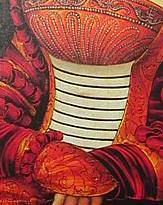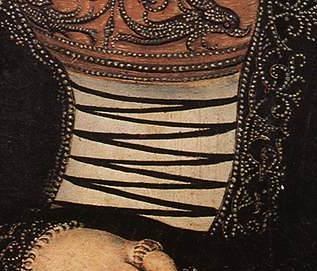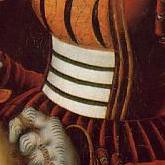So, some ideas on the actual construction. The question of the method for making one of these frocks seems to have been more hotly debated than the chicken or the egg. I have seen a number of these frocks which don't match some of the key features in the paintings, which has allowed me to see (without having to make a whole bunch of expensive mistakes myself) what they have been doing wrong.
Regardless of what method of construction you want to use, one thing is always apparent in the paintings. The stomacher/placket/white bit under the lacing in the front, is always (look at this rash use of the word always) flat and smooth.
See:

This is one of the things that leads me to belive that this frock was NOT an open fronted dress that was worn over the top of a chemise. Part of my evidence for this comes from looking at this style of dress made by other costumers - often no boning or other stiffening has been used, and this panel has been open to the underwear layer. The effect of this, when the wearer sits or bends, is that the lacing all migrates to the point of least resistance, leaving it sort of bunched up. Also, on an unwise wearer, it can make ones stomach look like a trussed ham. Ew!
So, this could be a boned panel, which is a separate piece to the brustfleck (breastband) or the whole front could be one piece (there is some evidence that this could be the case - in at least one of the 472,863 versions of the suicide of Lucrecia - I'll have to come back and fix that spelling later - the whole front of her dress is folded down to bear her chest, and appears to be all one piece.)
I also have somewhere (and when I find it I will upload it) a picture that shows a woman in an open fronted gown in a similar style, that shows this open section as red. You can also see lines of what could be boning or cording. It's plausable that this is a corded or reed boned corset/underbodice that can be seen through the lacing on the front of the gown.







3 comments:
I think...
I think there are lots of different dresses, lots of different paintings, and lots of different ways. Not just now, but hten too. I think you should do what ever you feel most comfortable with.
And that's the most unimportant post I've ever made on another person's blog...
Yes. This is just me sharing my thoughts with the world - in a kind of "this is my theroy, you may disagree, or you may learn something from it" kind of way.....
This is where I get embarassed that I have been so remiss as to forget half the images I am supposed to link to via FF because I have too many of the bloody things and I just go around in circles deciding what to work on.
In all the file snaffling and rearranging according to time and artist I haven't yet found a clear indication of when there might have been a shift (bad pun) from showing a Hemd (either the actual Hemd of a fake) and when there might be an alternative. By that I mean that once the Saxon style was established there is a mix of both. y personal feeling is for layers regardless of the apparent look. This is down to practicality (linen isn't really the only thing you want between you and a German winter (trust me on this.... darned snow on train tracks and hanging around for a bus....) and you really don't want a highly embroidered piece of linen being right next to your skin....
Then again we are talking about fashion and fashion has never been about sense;)
Post a Comment